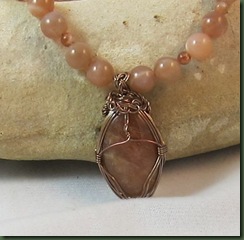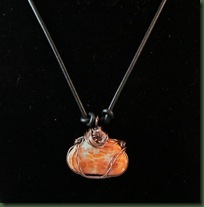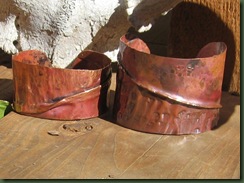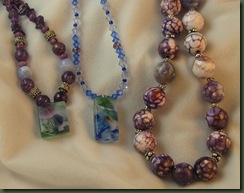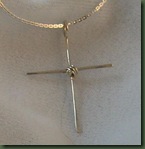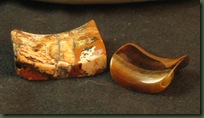How many times have you read that an artist gets inspiration from nature? If you aren’t “into” art, you’re laughing and saying “NEVER!” Yet if art and the process of making it does interest you, you’re probably thinking you’ve read or heard this many times. Whether it’s painting, sewing, making jewelry or most any other art form, the influence of nature is apparent.
One of my favorite boutique customers requested some new collage style necklaces on leather. I had fun making this type for her last Fall and it was time to add a Spring twist to things. Nature led the way for the two below.
The first piece features a dragonfly and a couple of lilies. My spouse assured me the lilies were upside down, but I hung them anyway. (Maybe they are lilies that didn’t get enough water and are hanging their heads down . . . ) I put these on a simple small S type link and then attached the leather through jump rings.
 The second necklace features a smaller dragonfly, a couple of bead dangles and a pea pod. The chain allows them to have a nice little swing. This piece has an interesting swirl bail at the top – one I don’t imagine I know how to make again. I think I have to be watching TV while I do it unconsciously! My friend, Shannon, of Vixens Natural Jewelry showed me how to made the pea pods. I also used her design to make some earrings. You will most certainly see the influence of nature in her work. You can check out her shop at http://www.facebook.com/#!/TreeandMoonJewelry?sk=app_169505045786
The second necklace features a smaller dragonfly, a couple of bead dangles and a pea pod. The chain allows them to have a nice little swing. This piece has an interesting swirl bail at the top – one I don’t imagine I know how to make again. I think I have to be watching TV while I do it unconsciously! My friend, Shannon, of Vixens Natural Jewelry showed me how to made the pea pods. I also used her design to make some earrings. You will most certainly see the influence of nature in her work. You can check out her shop at http://www.facebook.com/#!/TreeandMoonJewelry?sk=app_169505045786
 I made a third necklace, but it hasn’t quite taken off yet. I created a little wire bird and hung her with a bird’s nest and a cage. I was calling it freedom. Unfortunately, the cage seemed out of place; so that one is back on the workbench for further consideration. Perhaps it will fly before long.
I made a third necklace, but it hasn’t quite taken off yet. I created a little wire bird and hung her with a bird’s nest and a cage. I was calling it freedom. Unfortunately, the cage seemed out of place; so that one is back on the workbench for further consideration. Perhaps it will fly before long.
It’s a great day in Central Texas to be out with nature; so I think I’ll get out of the studio for a while and go study outside. Do you think I can call that work?


